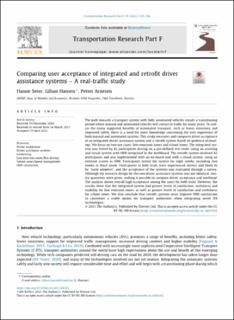| dc.contributor.author | Seter, Hanne | |
| dc.contributor.author | Hansen, Lillian | |
| dc.contributor.author | Arnesen, Petter | |
| dc.date.accessioned | 2021-05-26T12:25:35Z | |
| dc.date.available | 2021-05-26T12:25:35Z | |
| dc.date.created | 2021-05-21T08:53:10Z | |
| dc.date.issued | 2021 | |
| dc.identifier.issn | 1369-8478 | |
| dc.identifier.uri | https://hdl.handle.net/11250/2756460 | |
| dc.description.abstract | The path towards a transport system with fully automated vehicles entails a transitioning period where manual and automated vehicles will coexist in traffic for many years. To realize the many suggested benefits of automated transport, such as lower emissions and improved safety, there is a need for more knowledge concerning the user experience of both manual and automated systems. This study measures and compares driver acceptance of an integrated driver assistance system and a retrofit system based on geofence technology. We focus on two use cases: low-emission zones and school zones. The integrated system was tested by 43 participants driving on a pre-defined test route, using an assisting and visual system with HMI integrated in the dashboard. The retrofit system involved 42 participants and was implemented with an on-board unit with a visual system, using an external screen as HMI. Participants tested the system for eight weeks, including two weeks in black mode. Participants in both trials were experienced drivers and likely to be ‘‘early adopters”, and the acceptance of the systems was evaluated through a survey. Although the research design for the two driver assistance systems was not identical, similar questions were given, making it possible to compare driver acceptance and workload. The analysis shows overall high acceptance among the users for both trials. However, the results show that the integrated system had greater levels of satisfaction, usefulness and usability for low emission zones, as well as greater levels of satisfaction and usefulness for school zones. We also conclude that retrofit systems must improve HMI satisfaction to constitute a viable option for transport authorities when integrating novel ITS technologies. | en_US |
| dc.language.iso | eng | en_US |
| dc.publisher | Elsevier | en_US |
| dc.rights | CC BY-NC-ND | * |
| dc.rights.uri | http://creativecommons.org/licenses/by-nc-nd/4.0/ | * |
| dc.subject | Driver acceptance | en_US |
| dc.subject | Driver assistance systems | en_US |
| dc.subject | Geofencing | en_US |
| dc.subject | Low emission zones/Eco-driving | en_US |
| dc.subject | School zones/Speed management | en_US |
| dc.subject | HMI satisfaction | en_US |
| dc.title | Comparing user acceptance of integrated and retrofit driver assistance systems – A real-traffic study | en_US |
| dc.type | Peer reviewed | en_US |
| dc.type | Journal article | en_US |
| dc.description.version | publishedVersion | en_US |
| dc.rights.holder | © 2021 The authors | en_US |
| dc.subject.nsi | VDP::Teknologi: 500 | en_US |
| dc.source.pagenumber | 139-156 | en_US |
| dc.source.volume | 79 | en_US |
| dc.source.journal | Transportation Research Part F: Traffic Psychology and Behaviour | en_US |
| dc.identifier.doi | 10.1016/j.trf.2021.04.012 | |
| dc.identifier.cristin | 1911217 | |
| dc.relation.project | Norges forskningsråd: 283431 | en_US |
| cristin.ispublished | true | |
| cristin.fulltext | original | |
| cristin.qualitycode | 1 | |

